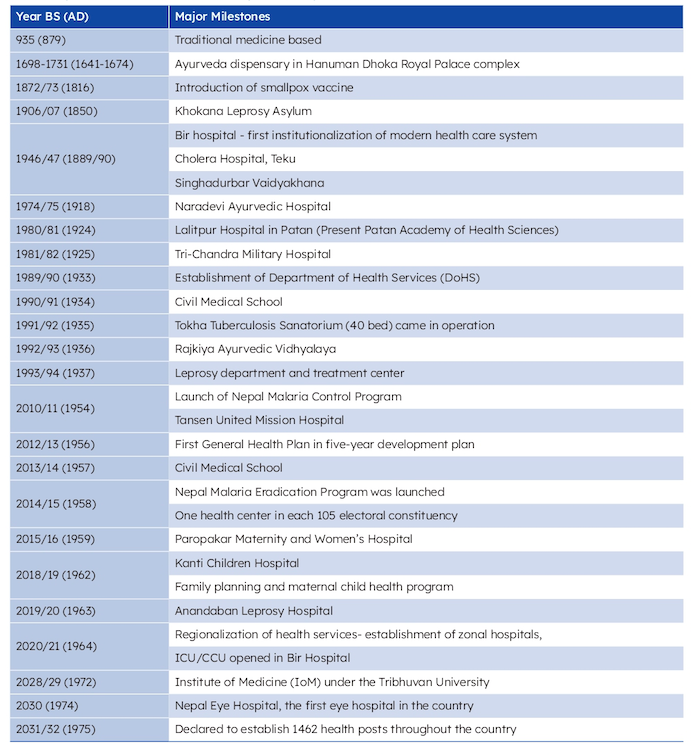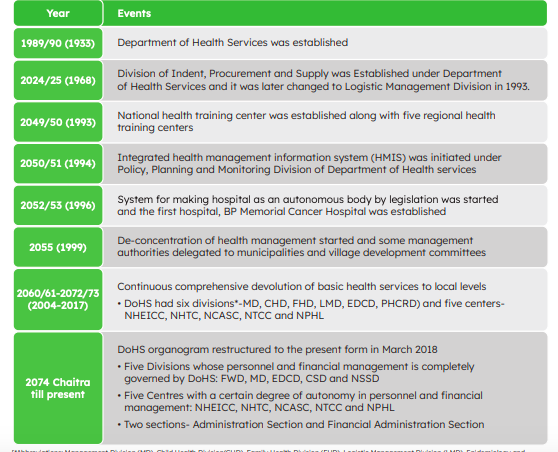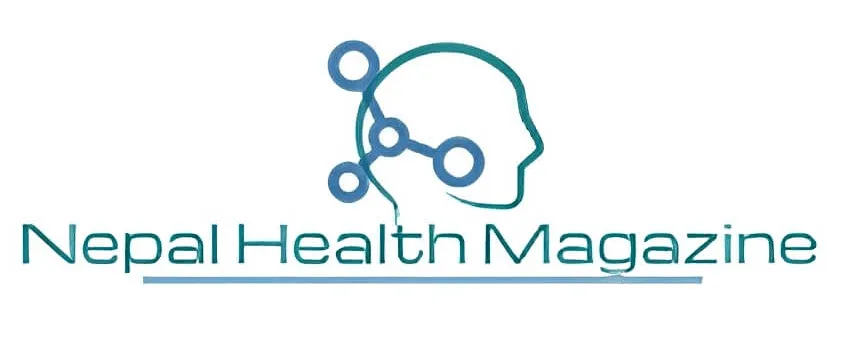Important milestones in the health system of Nepal: Until 935 BS (879 AD), Nepal’s health system predominantly relied on traditional medicine, particularly Ayurveda. Practices such as safe motherhood and the immediate cutting of the umbilical cord after childbirth were introduced, along with a code of conduct aimed at ensuring non-discrimination in healthcare services.During the Rana period (1766-2007 BS), efforts were made to fortify the traditional medicine system, and there was an integration of modern medical interventions. The year 1872/73 (1816) saw the introduction of smallpox vaccination, and efforts were initiated to establish modern hospitals and Ayurveda health facilities for accessible services. The first allopathic service hospital (Bir Hospital) was established in 1947 (1889/90). The formalization of modern health services took place with the establishment of the Department of Health Services (DoHS) in 1989/90 (1933).
The first General Health Plan in Nepal was introduced in 2012/13 (1956) as part of the First Five-Year Developmental Plan. From 2014/15 (1958), one health center was established per electoral constituency, and in 2031/32 (1975), an announcement was made for the establishment of 1462 health posts across the country. Vertical public health programs were continuously implemented alongside the establishment of health facilities for curative services.

In 2048 (1991), amidst the People’s Movement, the first National Health Policy (NHP) was promulgated, formalizing preventive, promotive, and curative aspects of healthcare. This policy also delineated various levels of health facilities, aimed to enhance rural accessibility through the establishment of health posts, and included private sector involvement. The National Drug Policy was formulated in 2052 (1995). The National Health Policy aimed for Health for All by 2057 (2000).
Subsequently, a new perspective plan was formulated and endorsed as the Second Long-Term Health Plan 2053/54-2073/74 (1997-2017), focusing on providing quality essential health care services (EHCS) and ongoing restructuring of health services, strengthening the district health system.
Aligned with the Poverty Reduction Strategy Paper, MDGs and Tenth Five-Year Plan 2058/59-2063/64 (2002-2007), the Government of Nepal formulated the Health Sector Strategy: An Agenda for Reform 2060/61-2065/66 (2004-2009) to provide equitable, high-quality healthcare. The implementation of a sector-wide approach (SWAp) under the Paris Declaration and joining the International Health Partnership (IHP+) in 2063/64 (2007) addressed coordination challenges, fostering the establishment of health facilities nationwide, including multispecialty centers and domestic health workforce production.
The mass movement (Jana Andolan) in 2062/63 led to revolutionary changes, a peace agreement, and the formation of an interim government, making Nepal a Federal Democratic Republic. The interim constitution of Nepal 2063 (2007) promoted Basic Health Services (BHS) free of cost, further enabling health sector development. As a result, Nepal went on track to achieve MDGs related to child health (MDG4) and maternal health (MDG5). The health sector efforts resulted in effectively controlling communicable diseases and the country’s progress towards MDG6 (HIV/AIDS and TB). This success resulted from policy reforms, partnerships, SWAp adoption, and a health sector reform strategy, leading to improved health outcomes and increased resources.
Building on lessons from the first sector strategy, Nepal Health Sector Program II (NHSP-II) 2066/67-2072/73 (2010-2015) prioritized health and nutrition improvement, poverty reduction through equitable healthcare access, and reduced catastrophic health expenses. During NHSP-II, the EHCS package expanded to address Nepal’s healthcare needs, incorporating mental health, oral health, environmental health, community-based newborn care, community-based nutrition care, and support. NHSP-II also included an NCD control component to address demographics and disease transition. Public-private partnerships, governance, accountability, inter-sectoral coordination, and sustainability were emphasized.
Under coordinated actions, Nepal achieved all targets for child health, reducing infant mortality rate (IMR) and under-five mortality rate (U5MR), and increasing measles immunization. IMR dropped from 64 in 2056/57 (2000) to 33 per 1,000 live births in 2071/72.

In 2071 (2014), a new national health policy was formulated with a focus on providing free basic health services (BHS), ensuring effective and accountable healthcare, improving accessibility and quality of services, and promoting community participation and ownership. Despite making gradual and significant progress in health outcomes, Nepal encountered additional challenges, particularly natural disasters, which severely affected the health system and hindered further progress in the country’s health status.
One such devastating event was the powerful earthquake that struck in Baishak 2072 (April 2015). The Health Emergency Operations Center (HEOC), established in 2071 (2014), played a pivotal role in coordinating disaster response efforts and ensuring the delivery of health services. The earthquake resulted in a tragic toll, with 8,962 deaths, 22,302 injuries, and extensive damage to infrastructure, including health facilities.Despite these challenges, the health sector demonstrated resilience, highlighting the importance of having a robust health system in place. Consequently, the agenda of post-disaster recovery and building resilience was incorporated into the subsequent health sector strategy.
- Webinar on World Hand Hygiene | Register today
- World’s First 5-in-1 vaccine against meningitis | Men5CV
- World Health Worker Week 2024 | Know theme
- World Autism Awareness Day 2024 | Know theme
- Staff Nurse | OCH | latest jobs vacancy 2024
- World Hepatitis Summit 2024 | WHO
- Staff Nurse | TLMN | ngo jobs 2024
- World Health Day 2024 | Know theme
- Measuring access to assistive technology in Nepal | Country Report
- Migration Health Nurse | IOM | ingo jobs
- Nursing Officer | Kopila Valley | nursing jobs 2024
- Benefits and risks of using artificial intelligence for pharmaceutical development and delivery | WHO
bachelor jobs bph jobs covid19 health health for all health guidelines new health jobs healthjobs healthjobs in nepal health jobs vacancy health public health update ingo jobs jobs after passing bachelor jobs for bph jobs in nepal jobs in ngo ngo jobs ngo jobs vacancy ngo jobs vacancy for bph ngo job vacancy 2021 nurse jobs nurse jobs 2021 nurse vacancy nursing insurance nursing job nursing jobs nursing jobs 2021 nursing jobs in nepal nursing law nursing officer Nursing Vacancy Public health Public health concern public health important days Public health in Nepal publichealth jobs public health updated Staff Nurse Staff Nurse and HA Vacancy | Nepal Army 2021 staff nurse vacancy staff nurse vacancy in ngo 2021 nepal staff nurse vacancy kathmandu who guidelines WHO official

Hey ! I am Nepal Health Magazine Bot , yet powerful enough to approve, disapprove , delete, ban anything and anyone.



